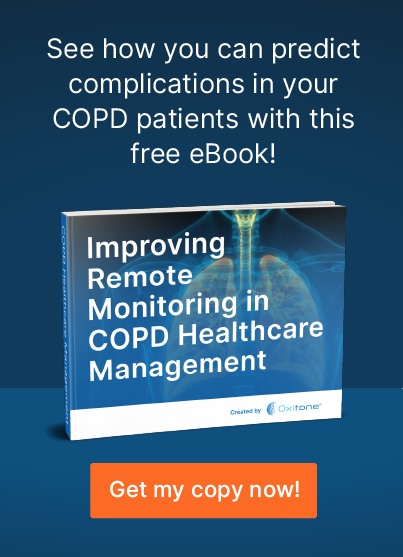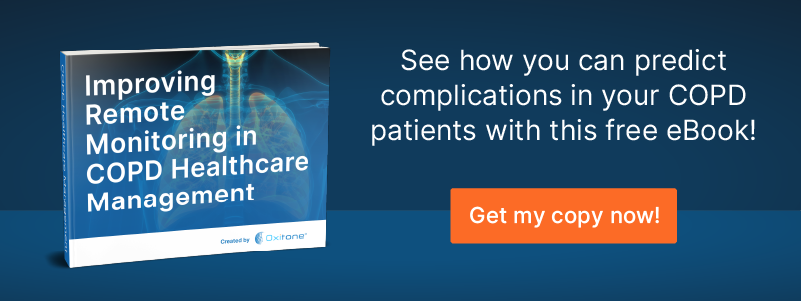Chronic obstructive pulmonary disease (COPD) affects one in eight Americans of ages forty-five or older. That means more than 16 million people have been diagnosed with COPD, a condition that makes it difficult to breathe. Tracking patient conditions is essential to monitor and treat patients properly, but this has been a significant challenge for patients and healthcare providers. However, recent breakthroughs have changed the way that patients can be monitored. Oxitone’s wrist-sensor pulse oximetry monitor, for example, has remote monitoring. This means that real-time data is sent to healthcare producers so they can make better medical decisions for their patients. This device also uses artificial intelligence (AI). AI fuels predictive analytics, which can catch escalating symptoms that require intervention before they escalate, improving COPD care at scale. This allows treatment and care management to be adjusted more rapidly.
Managing COPD
While there is no cure for COPD, it can be treated. Healthcare professionals can manage the symptoms to improve the quality of life for patients and diagnose the progression of the disease with proactive care. Conditions can change rapidly, so tracking patient status is crucial.
For physicians, patient tracking creates an additional workload. Currently, 20% of severe chronic patients consume 80% of healthcare expenses.
Healthcare professionals today are overwhelmed and dealing with their own stress, anxiety, and frustration. Warning signs can easily get missed, especially because patients often don’t share critical information with their healthcare providers. AI-enhanced remote patient monitoring can solve this problem. It also allows clinicians to scale monitoring and patient care.
AI-Enhanced Remote Patient Monitoring
Remote patient monitoring, such as via the Oxitone 1000M, provides real-time data right from the patient’s wrist to medical professionals.
AI provides continuous monitoring against baselines that help clinicians adapt care and intervention protocols. By collecting specific, detailed, and accurate data about patients, even minor deviations in conditions will be noted. Also, AI predictive analysis can foretell changes that need attention and provide earlier detection of life-threatening events.
Because COPD has such a high readmission rate, AI-enabled real-time monitoring helps avoid ER visits and hospitalization. It also optimizes home treatment for mild exacerbations.
AI-enhanced remote patient monitoring results in:
- Optimization of clinical time
- Reduction in patient care costs
- Alleviated burden on patients and clinicians
- Ability to spot potential exacerbations before they begin
Remote monitoring closes the gap in the physician’s care circle, which depends on a constant information flow from the patient to their medical providers to help manage their care. Clinicians can be proactive in their treatment to help manage conditions, thereby improving COPD care at scale.
Quite simply, real-time remote monitoring with AI and predictive analysis is an easier way to improve patient care while reducing the workload and costs associated with providing high-quality care.
Better COPD Patient Monitoring
Oxtione is a better monitoring solution than traditional pulse oximeters. It is the first FDA-cleared wrist-sensor health monitor without a fingertip probe. It’s a simple-to-use wearable monitor that automatically creates consistent, continuous, high-quality medical data, including:
- Blood oxygen (SpO2)
- Pulse rate and HRV
- Respiratory rate
- Activity and sleep detection
- Skin temperature
Because oxygen saturation is thought to be a predictor of exacerbations in COPD patients, close monitoring can help provide early warning. Traditional pulse oximeters only show snapshots of a patient’s SpO2. Continuous remote patient monitoring (CRPM) automatically provides a constant flow of patient data, and doctors can monitor patients without having to tie up appointment times.
A continuous data flow helps doctors and patients avoid mistaking natural fluctuations from more severe complications. When patients are wearing their CRPM device, it encourages them to take a more active role in their care and disease self-management and be more aware of the warning signs and potential triggers.
COPD can cause many other complications that can impact patient health. For example, patients with COPD are more likely to get ill from colds, flu, or pneumonia. Respiratory infections can damage lung tissues and make it even more difficult to breathe. Patients are at higher risk of developing lung cancer and high blood pressure in lung arteries. COPD can also increase the risk for heart disease and heart attacks.
Real-time monitoring with AI and predictive analysis can help prevent these complications by surfacing potential issues earlier, preventing serious exacerbations, and improving COPD care at scale.
AI-Aided Continuous Remote Patient Monitoring with Oxitone
The Oxitone wrist-sensor pulse oximetry monitor does not require a fingertip probe, has a rechargeable long-life battery, and connects via Bluetooth. The Oxitone 1000M has demonstrated superior accuracy through numerous clinic pilots and is cleared for use by the FDA and certified by CE. To learn more about the power of AI-aided continuous remote patient monitoring, contact the experts at Oxitone today.
Here at Oxitone, we boost value-based healthcare by delivering extraordinary patient, clinical, and economical outcomes at reduced medical utilization and cost. Patients need a prompt response to emergencies. Physicians need an easy and timely follow-up with patients. Our mission is to transform chronic disease management and help save lives worldwide.
Let’s save lives together! To see how we help remote patient monitoring companies and physicians improve the management and care of high-risk patients, contact us today!


